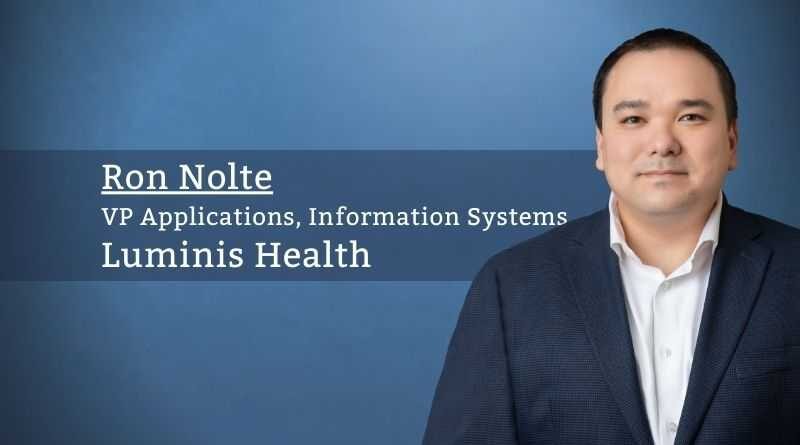How COVID-19 and Landscape Changes are Accelerating Connected Health Adoption
By Ron Nolte, VP Applications, Information Systems, Luminis Health
Connected health has been a target without focus for more than twenty years, that is up until two years ago. The COVID-19 pandemic has accelerated connected health adoption around five years, but the 21st Century Cures Act came into place, payers adopted reimbursement strategies that embrace connected health. As a result, we are seeing development in technology solutions that are more refined and user-friendly.
Pre-COVID, Luminis Health was piloting video telemedicine visits. Our goal then was to have greater than 100 video telemedicine visits in a month. Two of the problems faced at that time were structuring a telemedicine program that ensured reimbursement for telemedicine encounters and finding ways to encourage providers to change their business approach when things were working just fine.
Luminis Health was also piloting take-home wearables for expectant mothers that would automatically populate the patient’s chart. The appeal of this program was to control pre-eclampsia in expectant mothers. The barrier here was finding blood pressure cuffs that our development team could integrate with. Many of the cuffs used proprietary protocols or had limited ways to integrate their data.
Looking toward the horizon, connected health technologies are here to stay and each healthcare organization will have to maintain and expand their footprint in these spaces.
After the emergence of COVID-19 in the United States, our telemedicine adoption numbers raced past what just a month earlier was a lofty goal. Instead of discussing how the team could drum up support for 100 video telemedicine visits per month, we were looking to scale our support and architecture to support 13,000+ video telemedicine visits in a month.
Our remote patient monitoring program also grew dramatically. In May of 2020, we were awarded an
Federal Communications Commission (FCC) telemedicine grant that allowed us to procure single-use low acuity monitors. These monitors were distributed to two groups of patients. The first group was returning home after an inpatient hospitalization for COVID-19 and met a specific set of criteria. The second group was referred to the program by their primary care provider with the goal of preventing emergency department admissions. Patients would then use their personal smartphone, or one that we provided, to integrate to the monitoring device and transmit the data to our clinical care coordination teams and primary care providers. Using this solution, we were able to have 549 patients either recover from COVID-19 at home or monitor patients that were at risk of needing emergency services and proactively provide care before the need for the emergency department presented.
What changed? In that brief period of time, we found payers remove barriers to reimbursement, we were fortunate enough to receive a grant to help shoulder the cost of the single-use low acuity monitors, a market had been established for cost-effective connected health devices, and perhaps most importantly, patients and clinicians have embraced this shift in care delivery and saw the value to care it provided.
Pre-COVID, numerous concerns were elevated around patient hesitancy or access to technology, and to a lesser degree, the level of trust for data not captured in the exam room. Now, most will agree that patients have less of a technology barrier as we once thought, and that wearable data or remote patient monitoring is reliable data that can positively impact patient care.
Luminis Health was better positioned to respond to all of these changes due to active deployment of controlled pilots such as telemedicine and remote patient monitoring. Several years earlier, we made the active decision to have a dedicated software development team that we could leverage to accelerate changes to software systems. We also have executive support from the CEO down to run these pilots in a risk-controlled and patient-centric way. These factors allowed Luminis Health to pilot the operationalization of connected health technologies. Once conditions were right, we were able to rapidly scale both the technology and operationalization footprints.
Looking toward the horizon, connected health technologies are here to stay and each healthcare organization will have to maintain and expand their footprint in these spaces. The reasons are simple: healthcare organization next door will be, patients are going to continue to expect it, and healthcare disruptors will be capitalizing in this area. 21st Century Cures Act mandates data exchange, which will empower patient choice. Consequently, healthcare disruptors that offer such healthcare products have significant room to grow.
At Luminis Health, we are tackling many of these strategies with our new digital front door experience that prioritizes patient access while minimizing the need for staff access. For example, we are focusing on expanding and allowing patients to schedule a broader number of types of visits directly on the provider’s schedule without having to place calls or wait for callbacks. We are also investing in technologies that allow for more seamless sharing of information and data from the patient to the provider and the provider to the patient. Lastly, we are exploring how we can leverage our technologies and operational experience to provide telemedicine visits on-demand without having to wait for a scheduled slot with a caregiver.
Wearables, telemedicine, remote patient monitoring, and other connected health technologies are truly exciting, but this also presents a new way of operating. The sheer amount of data and expectation for immediacy is causing transformation. These technologies create new and different workloads for our caregivers at a point in time when we are at crisis levels in terms of provider and nurse satisfaction. All of this data needs to be assessed by the care teams, and actions will need to be taken. This is where I personally hope to see more technology focus. Advanced surveillance algorithms and mechanisms are needed for the next evolution of connected health.



